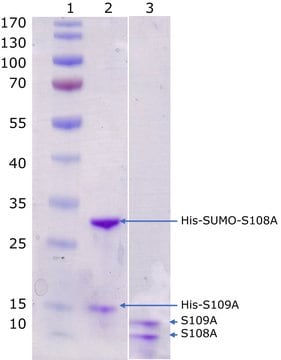MABF854
Anti-S100A9 Antibody, clone 6B4
clone 6B4, from mouse
Sinónimos:
Protein S100-A9, Calgranulin-B, Calprotectin L1H subunit, Leukocyte L1 complex heavy chain, Migration inhibitory factor-related protein 14, MRP-14, p14, S100 calcium-binding protein A9, S100A9
About This Item
Productos recomendados
biological source
mouse
Quality Level
antibody form
purified immunoglobulin
antibody product type
primary antibodies
clone
6B4, monoclonal
species reactivity
human
should not react with
mouse
technique(s)
ELISA: suitable
western blot: suitable
isotype
IgG1κ
NCBI accession no.
UniProt accession no.
shipped in
dry ice
target post-translational modification
unmodified
Gene Information
human ... S100A9(6280)
General description
Specificity
Immunogen
Application
Inflammation & Immunology
Immunoglobulins & Immunology
ELISA Analysis: A representative lot detected recombinant human S100A9 (rhS100A9) by direct/non-sandwich ELISA, but not rhS100A8 & rhS100A12 or recombinant murine S100A8 & S100A9 (Dr Philippe Tessier, Laval University, Quebec, CA).
ELISA Analysis: A representative lot detected recombinant human S100A9 (rhS100A9) as well as endogenous S100A9 in purified human calprotectin (S100A8/S100A9 dimer) by sandwich ELISA, but not rhS100A8 or rhS100A12 (Dr Philippe Tessier, Laval University, Quebec, CA).
Quality
Western Blotting Analysis: 0.1 µg/mL of this antibody detected S100A9 in 10 µg of human spleen tissue lysate.
Target description
Physical form
Storage and Stability
Handling Recommendations: Upon receipt and prior to removing the cap, centrifuge the vial and gently mix the solution. Aliquot into microcentrifuge tubes and store at -20°C. Avoid repeated freeze/thaw cycles, which may damage IgG and affect product performance.
Other Notes
Disclaimer
Not finding the right product?
Try our Herramienta de selección de productos.
Storage Class
12 - Non Combustible Liquids
wgk_germany
WGK 2
flash_point_f
Not applicable
flash_point_c
Not applicable
Certificados de análisis (COA)
Busque Certificados de análisis (COA) introduciendo el número de lote del producto. Los números de lote se encuentran en la etiqueta del producto después de las palabras «Lot» o «Batch»
¿Ya tiene este producto?
Encuentre la documentación para los productos que ha comprado recientemente en la Biblioteca de documentos.
Nuestro equipo de científicos tiene experiencia en todas las áreas de investigación: Ciencias de la vida, Ciencia de los materiales, Síntesis química, Cromatografía, Analítica y muchas otras.
Póngase en contacto con el Servicio técnico








